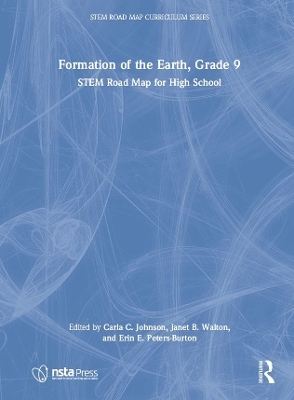
Formation of the Earth, Grade 9
Routledge (Verlag)
978-1-032-19991-7 (ISBN)
Formation of the Earth outlines a journey that will steer your students toward authentic problem solving while grounding them in integrated STEM disciplines. Like the other volumes in the series, this book is designed to meet the growing need to infuse real-world learning into K–12 classrooms.
This interdisciplinary, three-lesson module uses project- and problem-based learning to help students investigate how Earth science professionals gather information and develop theories about the formation of the Earth and the processes taking place since the proliferation of humans. Working in teams, students will work to identify, define and describe the attributes scientists use to delineate Earth’s eras, periods, and epochs, in order to determine the appropriate boundary event to define the Anthropocene Epoch, and will develop a publication-ready textbook entry for an Earth science textbook. To support this goal, students will do the following:
• Identify, define, and describe attributes of eras, periods, and epochs which have marked geologic time in Earth’s history.
• Evaluate various possible index layers and boundary events that mark the beginning of the Anthropocene Epoch to determine which is most appropriate when labeling the current epoch in Earth’s history.
• Design and present a multimedia presentation to share with textbook publishers regarding information on the Anthropocene Epoch, to include in a secondary-level Earth science textbook.
• Create a publication-ready textbook entry describing the Anthropocene Epoch.
The STEM Road Map Curriculum Series is anchored in the Next Generation Science Standards, the Common Core State Standards, and the Framework for 21st Century Learning. In-depth and flexible, Formation of the Earth can be used as a whole unit or in part to meet the needs of districts, schools, and teachers who are charting a course toward an integrated STEM approach.
Carla C. Johnson is Professor of Science Education in the College of Education and Office of Research and Innovation, and a Faculty Research Fellow at North Carolina State University in North Carolina, USA Janet B. Walton is Senior Research Scholar at North Carolina State University in North Carolina, USA Erin E. Peters-Burton is the Donna R. and David E. Sterling Endowed Professor in Science Education at George Mason University in Virginia, USA
Part 1: The STEM Road Map: Background, Theory, and Practice
1 Overview of the STEM Road Map Curriculum
2 Strategies Used in the STEM Road Map Curriculum
Part 2: Formation of the Earth: STEM Road Map Module
3 Formation of the Earth Module Overview
4 Formation of the Earth Lesson Plans
5 Transforming Learning with Formation of the Earth and the STEM Road Map Curriculum Series
| Erscheinungsdatum | 03.05.2022 |
|---|---|
| Reihe/Serie | STEM Road Map Curriculum Series |
| Zusatzinfo | 42 Tables, black and white; 2 Line drawings, black and white; 2 Illustrations, black and white |
| Verlagsort | London |
| Sprache | englisch |
| Maße | 210 x 280 mm |
| Gewicht | 571 g |
| Themenwelt | Schulbuch / Wörterbuch ► Unterrichtsvorbereitung |
| Naturwissenschaften ► Geowissenschaften ► Geologie | |
| Sozialwissenschaften ► Pädagogik ► Schulpädagogik / Sekundarstufe I+II | |
| ISBN-10 | 1-032-19991-1 / 1032199911 |
| ISBN-13 | 978-1-032-19991-7 / 9781032199917 |
| Zustand | Neuware |
| Informationen gemäß Produktsicherheitsverordnung (GPSR) | |
| Haben Sie eine Frage zum Produkt? |
aus dem Bereich


